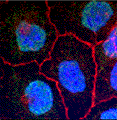Biochemistry, Department of
Document Type
Article
Date of this Version
9-2016
Citation
Frontiers in Cell and Developmental Biology, October 2016, Volume 4, Article 109.
http://journal.frontiersin.org/article/10.3389/fcell.2016.00109/full
Abstract
Normal cellular physiology is critically dependent on numerous mitochondrial activities including energy conversion, cofactor and precursor metabolite synthesis, and regulation of ion and redox homeostasis. Advances in mitochondrial research during the last two decades provide solid evidence that these organelles are deeply integrated with the rest of the cell and multiple mechanisms are in place to monitor and communicate functional states of mitochondria. In many cases, however, the exact molecular nature of various mitochondria-to-cell communication pathways is only beginning to emerge. Here, we review various signals emitted by distressed or dysfunctional mitochondria and the stress-responsive pathways activated in response to these signals in order to restore mitochondrial function and promote cellular survival.
Included in
Biochemistry Commons, Biotechnology Commons, Other Biochemistry, Biophysics, and Structural Biology Commons



Comments
Copyright © 2016 Bohovych and Khalimonchuk. This is an open-access article distributed under the terms of the Creative Commons Attribution License